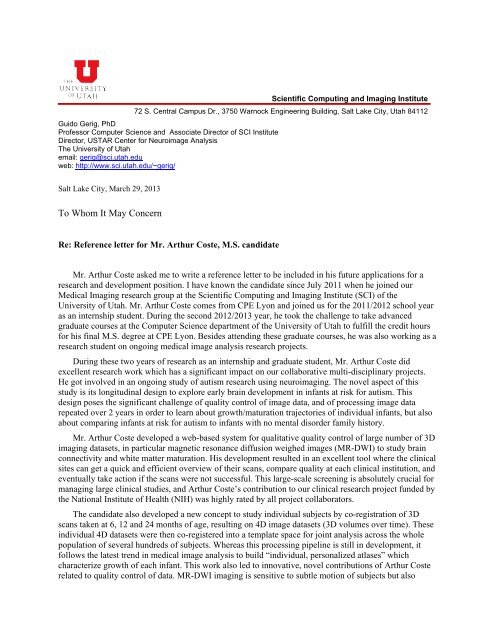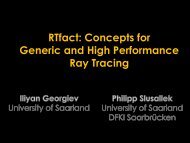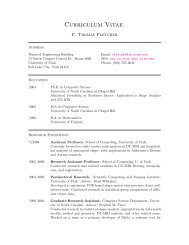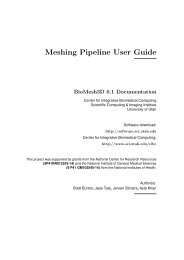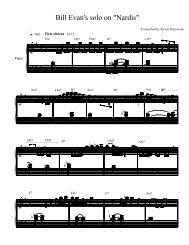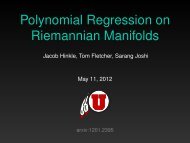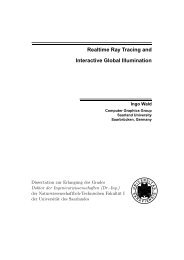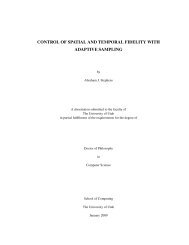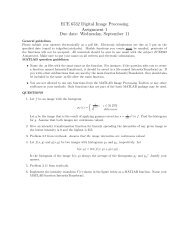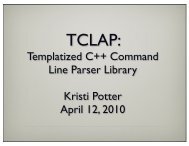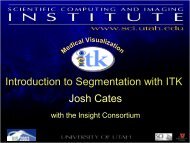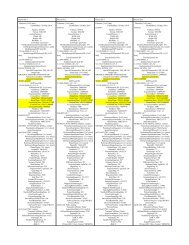To Whom It May Concern - Scientific Computing and Imaging ...
To Whom It May Concern - Scientific Computing and Imaging ...
To Whom It May Concern - Scientific Computing and Imaging ...
You also want an ePaper? Increase the reach of your titles
YUMPU automatically turns print PDFs into web optimized ePapers that Google loves.
<strong>Scientific</strong> <strong>Computing</strong> <strong>and</strong> <strong>Imaging</strong> Institute<br />
72 S. Central Campus Dr., 3750 Warnock Engineering Building, Salt Lake City, Utah 84112<br />
Guido Gerig, PhD<br />
Professor Computer Science <strong>and</strong> Associate Director of SCI Institute<br />
Director, USTAR Center for Neuroimage Analysis<br />
The University of Utah<br />
email: gerig@sci.utah.edu<br />
web: http://www.sci.utah.edu/~gerig/<br />
Salt Lake City, March 29, 2013<br />
<strong>To</strong> <strong>Whom</strong> <strong>It</strong> <strong>May</strong> <strong>Concern</strong><br />
Re: Reference letter for Mr. Arthur Coste, M.S. c<strong>and</strong>idate<br />
Mr. Arthur Coste asked me to write a reference letter to be included in his future applications for a<br />
research <strong>and</strong> development position. I have known the c<strong>and</strong>idate since July 2011 when he joined our<br />
Medical <strong>Imaging</strong> research group at the <strong>Scientific</strong> <strong>Computing</strong> <strong>and</strong> <strong>Imaging</strong> Institute (SCI) of the<br />
University of Utah. Mr. Arthur Coste comes from CPE Lyon <strong>and</strong> joined us for the 2011/2012 school year<br />
as an internship student. During the second 2012/2013 year, he took the challenge to take advanced<br />
graduate courses at the Computer Science department of the University of Utah to fulfill the credit hours<br />
for his final M.S. degree at CPE Lyon. Besides attending these graduate courses, he was also working as a<br />
research student on ongoing medical image analysis research projects.<br />
During these two years of research as an internship <strong>and</strong> graduate student, Mr. Arthur Coste did<br />
excellent research work which has a significant impact on our collaborative multi-disciplinary projects.<br />
He got involved in an ongoing study of autism research using neuroimaging. The novel aspect of this<br />
study is its longitudinal design to explore early brain development in infants at risk for autism. This<br />
design poses the significant challenge of quality control of image data, <strong>and</strong> of processing image data<br />
repeated over 2 years in order to learn about growth/maturation trajectories of individual infants, but also<br />
about comparing infants at risk for autism to infants with no mental disorder family history.<br />
Mr. Arthur Coste developed a web-based system for qualitative quality control of large number of 3D<br />
imaging datasets, in particular magnetic resonance diffusion weighed images (MR-DWI) to study brain<br />
connectivity <strong>and</strong> white matter maturation. His development resulted in an excellent tool where the clinical<br />
sites can get a quick <strong>and</strong> efficient overview of their scans, compare quality at each clinical institution, <strong>and</strong><br />
eventually take action if the scans were not successful. This large-scale screening is absolutely crucial for<br />
managing large clinical studies, <strong>and</strong> Arthur Coste’s contribution to our clinical research project funded by<br />
the National Institute of Health (NIH) was highly rated by all project collaborators.<br />
The c<strong>and</strong>idate also developed a new concept to study individual subjects by co-registration of 3D<br />
scans taken at 6, 12 <strong>and</strong> 24 months of age, resulting on 4D image datasets (3D volumes over time). These<br />
individual 4D datasets were then co-registered into a template space for joint analysis across the whole<br />
population of several hundreds of subjects. Whereas this processing pipeline is still in development, it<br />
follows the latest trend in medical image analysis to build “individual, personalized atlases” which<br />
characterize growth of each infant. This work also led to innovative, novel contributions of Arthur Coste<br />
related to quality control of data. MR-DWI imaging is sensitive to subtle motion of subjects but also
small vibrations of scanners. Here, the c<strong>and</strong>idate developed new analysis procedures that can detect <strong>and</strong><br />
quantify parts of scans which are considered “bad” in order to correct datasets. This research is taken to<br />
the next level where he is developing a tool to quantify errors of individual datasets during population<br />
atlas-building, <strong>and</strong> to systematically compare different parameter combinations used for the processing<br />
pipeline. All these research contributions are well documented with regular updates which Arthur Coste<br />
provided on our internal Wiki research page, including reports, visualizations of processing pipelines <strong>and</strong><br />
pictures <strong>and</strong> 3D views of results. Overall, the 2 years of research <strong>and</strong> development by Arthur Coste<br />
provided substantial support of technology development towards our ongoing autism research project. He<br />
well demonstrated his excellent computing skills based on strong foundations of knowledge of algorithms<br />
<strong>and</strong> numerical solutions.<br />
Mr. Arthur Coste was also attending two high-level graduate courses which I was teaching. In the<br />
CS6640 Image Processing Course in Fall 2012, he did excellent <strong>and</strong> was among the 5 best students out of<br />
37 students. In the CS6620 3D Computer Vision Course this Spring 2013, he ranks among the 3 best out<br />
of 15 students. His assignments <strong>and</strong> computer science projects were always excellent, reflected his<br />
motivation to better underst<strong>and</strong> theory, searching for additional materials, <strong>and</strong> presenting excellent <strong>and</strong><br />
detailed reports <strong>and</strong> also well-documented computer code.<br />
In summary, I am pleased to recommend Mr. Arthur Coste highly for a future position related to<br />
computer science <strong>and</strong> imaging technology development <strong>and</strong> research. He has clearly demonstrated his<br />
strong theoretical <strong>and</strong> practical background as a computer scientist, his style of working hard <strong>and</strong><br />
independently to come up with his own solutions, his well-demonstrated skills to work in a team <strong>and</strong> to<br />
communicate research to others, <strong>and</strong> to quickly capture the underlying issues with new scientific<br />
problems <strong>and</strong> to investigate about optimal solutions. His oral <strong>and</strong> written communication skills are to be<br />
considered as excellent. I therefore strongly recommend Mr. Arthur Coste for a future position <strong>and</strong> I think<br />
he will have an excellent career ahead.<br />
I will be happy to provide additional information if necessary.<br />
Sincerely,<br />
Guido Gerig, PhD


